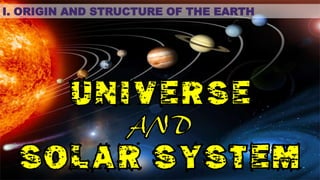
Origin and Structure of the Solar System - Formation of Planets, Moons, Comets and Asteroids
- 1. I. ORIGIN AND STRUCTURE OF THE EARTH
- 2. CONTENT STANDARD The learners demonstrate an understanding of the formation of the universe and the solar system
- 3. LEARNING COMPETENCIES The learners: 1. State the different hypotheses explaining the origin of the universe. 2. Describe the different hypotheses explaining the origin of the solar system.
- 4. COSMOLOGY is the branch of science that studies the origin, evolution and fate of the universe
- 5. ACTIVITY #1 : JUMBLED WORD VISUAL CLUE ANSWER A G R E L LARGE A S G GAS
- 6. ACTIVITY #1 : JUMBLED WORD VISUAL CLUE ANSWER A R S T S STARS SUDT LODUSC DUST CLOUDS
- 7. ACTIVITY #1 : JUMBLED WORD VISUAL CLUE ANSWER SPL TANE PLANETS L X G A A Y GALAXY
- 8. The UNIVERSE is a (1) _________ unimaginable expanse of (2) ___________, (3) _________, (4) _________, and consists of (5)_________ and (6)____________. large gas stars dust clouds planets galaxy
- 9. UNIVERSE is large unimaginable expanse of gas, stars, dust clouds, and consists of planets and galaxy.
- 10. Big Bang Theory
- 11. Steady State / Infinite Universe Theory
- 14. SOLAR SYSTEM is the gravitationally bound system comprising the Sun and the objects that orbit around it, either directly or indirectly.
- 15. SOLAR SYSTEM it is in constant motion, with the planets and their moons, comets, asteroids and other space objects revolving around the Sun.
- 18. The masses of the planets are also concentrated in the Gas Giant planets Jupiter, Saturn, Uranus, and Neptune.
- 19. • The large mass of these planets comes from their absolute sizes, not their densities. • The inner planets are by far the most dense.
- 20. TERRESTRIAL (Inner Planets) • made of materials with high melting points such as silicates, iron , and nickel • rotate slower, have thin or no atmosphere Mercury Venus Earth Mars
- 21. JOVIAN (Outer Planets) • gas giants • rotate faster • have thick atmosphere
- 23. PLANET BIYO is a minor planet named after a Filipino teacher, Dr. Josette Biyo Planet 13241 Found in the Main Asteroid Belt between Mars and Jupiter
- 24. 1) MERCURY • INNERMOST AND SWIFTEST PLANET • ALBEDO 0F 6% • DAYLIGHT & DARKNESS BOTH LAST 88 DAYS • TEMPERATURE RANGE OF -300F TO 800F • VERY LITTLE ATMOSPHERE
- 26. 2) VENUS • SIMILAR IN SIZE, DENSITY AND MASS TO EARTH • THICK CLOUD OF CARBON DIOXIDE • SURFACE TEMPS OF 900F DUE TO GREENHOUSE EFFECT • ATMOSPHERIC PRESSURE IS 90 TIMES THAT OF EARTH • IF EARTH IS HEAVEN THEN VENUS IS HELL
- 29. 4) MARS • WHITE POLAR ICE CAPS • HAVE GREAT RIFT VALLEY • VERY DRY PLANET • REDDISH ROCK, SAND AND SOIL
- 31. 5) JUPITER • 2 1/2 TIMES LARGER THAN ALL OTHER PLANETS COMBINED • 1 DAY LASTS 10 HOURS DUE TO FAST ROTATION • HURRICANE-LIKE STORM SYSTEMS WITH WINDS OF 1000 MPH - GREAT RED SPOT • SURFACE OF LIQUID HYDROGEN OCEAN • SOME MOONS [61] AS LARGE AS MARS
- 33. MOONS OF JUPITER DISCOVERED BY GALILELO 61? TOTAL MOONS • CALLISTO • GANYMEDE • IO • EUROPA
- 34. 6) SATURN • 29 1/2 YEARS TO MAKE ONE REVOLUTION • SYSTEM OF RINGS • HIGH WIND SPEEDS 1000+ MPH
- 36. 7) URANUS • SURROUNDED BY POLAR CIRCLING RINGS • KNOWN AS THE GREEN PLANET • METHANE IN ATMOSPHERE • ROTATES ON ITS SIDE
- 38. 8) NEPTUNE • TWIN PLANET TO URANUS • BY POLAR CIRCLING RINGS • KNOWN AS THE GREEN PLANET • METHANE IN ATMOSPHERE • ROTATES ON ITS SIDE
- 40. 9) PLUTO • MAY NOT BE A PLANET BUT A TRANSITION BETWEEN COMET AND PLANET • AVERAGE TEMP OF -350F • LARGE DIRTY ICEBALL • 248 YEARS TO ORBIT SUN
- 41. MINOR MEMBERS OF THE SOLAR SYSTEM 1) COMETS 2) ASTEROIDS 3) METEOROIDS
- 42. MINOR MEMBERS OF THE SOLAR SYSTEM COMETS Often compared to large, “dirty snowballs” Composition: • Frozen gases • Rocky and metallic materials • Frozen gases vaporize when near the Sun • Produces a glowing head called the coma • Some may develop a tail that points away from Sun due to radiation pressure and the solar wind
- 43. ORIENTATION OF A COMET’S TAIL AS IT ORBITS THE SUN Figure 22.27
- 44. HALE-BOPP
- 45. SUNSINGER
- 46. MINOR MEMBERS OF THE SOLAR SYSTEM ASTEROIDS • Irregular shapes AND Origin is uncertain • Most lie between Mars and Jupiter • Small bodies – largest (Ceres) is about 620 miles in diameter • Some have very eccentric orbits • Many of the recent impacts on the Moon and Earth were collisions with asteroids
- 47. THE ORBITS OF MOST ASTEROIDS LIE BETWEEN MARS AND JUPITER Figure 22.25
- 48. MINOR MEMBERS OF THE SOLAR SYSTEM METEOROIDS • are called meteors when they enter Earth’s atmosphere • are called as meteorites when they are found on Earth • A meteor shower occurs when Earth encounters a swarm of meteoroids associated with a comet’s path
- 49. References • Earth and Life Science
